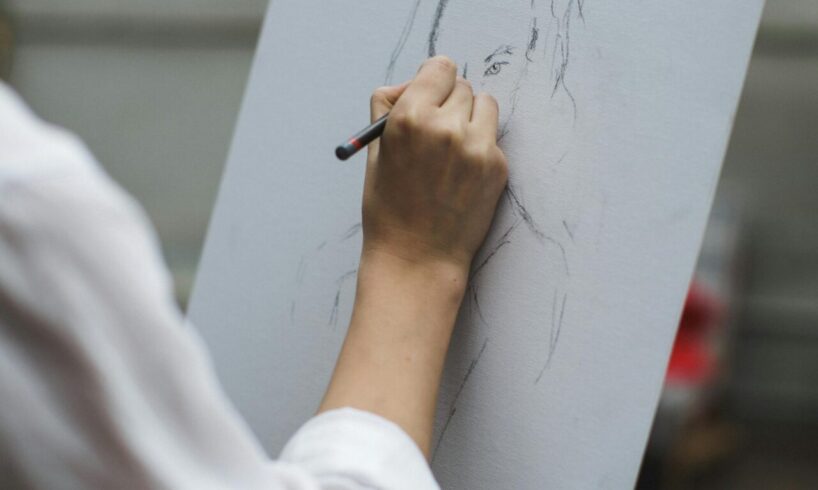
The very first step to take as an artist is pencil sketching. Dreaming of holding your very own pencil sketch gallery is what every artist craves! While you choose to use different types of pencils—graphite or colored—the technique to get the best pencil sketch eventually is the same.
For a variety of artists, sketching is the introductory class to the world of art, whether it is abstract or modern, acrylic painting or glass. Basic sketching is what helps an individual grow.
Let’s learn about the basic techniques that every sketch artist must know:
Using the Correct Pencil Grip and Considering the Correct Lines
The very first and most basic step is to choose the pencil. Once you decide whether your pencil is graphite or led, you must hold it the same as a piece of charcoal. Make sure that the sides of the same are used to lead your drawing instead of the point. When we do not use the point of the pencil to sketch but only the sides, the pencil remains sharper for a long time. Once you start getting perpendicular to the line you are sketching, the drawing becomes wide and holds soft lines.
Speaking of the lines, the type of marks that you make will eventually shape the look and feel of your pencil sketch. Little things, like your weight on the pencil or how fast you draw, have a great impact on your drawing. When you initially start your drawing, try to avoid feathery and unwanted marks.
Underdrawing the Pencil Sketch Gallery
A lot of artists prefer to start their drawings by laying out a light and rough underdrawing. This is usually helpful if precise line drawing is the endgame for all. Holding on to a fluid foundation makes you see the end result without many intimidating statements about getting the best. Make sure that you use a ‘Hard Lead’, ensuring the lines are light and easy to edit, or rather erase.
The Idea of Working from Left to Right
Well, we all know that sketching can be really untidy; therefore, when planning an area of composition, you must start your work, which you should finalize. This helps to keep the drawing from smudging too. You must make sure that the unusual pencil grip is formed to prevent pressing your hands on the drawing you have been working on. One of the easiest hacks to resolve the untidy issue is that the right-handers can and should work from left to right and vice versa.
Shading Techniques and Their Mix-Ups
There are a lot of different drawing techniques using pencils, usually related to shading. Out of them all, there are two main approaches, such as shading all the lines in the same direction. This will make your drawing more cohesive and initiate detailing within the lines using shading. The second method is that of working in patches to define the shape perfectly. The patches help the lines move around the form, keeping the perspective of the drawing on point.
Soft Blending
The final results of your drawings depend on how you blend them. When you blend with a blending stump, a soft texture appears between the blended effects. You must ensure that after each light layer, a gentle blend of the colors is well-stretched.Make sure that you keep the pencil as light as possible. You can repeat this step as many times as possible, coming up with a delicate and softer look.
Wrapping Up
While a lot of people look for techniques to learn to sketch, reputed pencil sketching galleries are available all over the internet with amazing art pieces. So while you learn online, give yourself a little treat by buying art online.
The very first step to take as an artist is pencil sketching. Dreaming of holding your very own pencil sketch gallery is what every artist craves! While you choose to use different types of pencils—graphite or colored—the technique to get the best pencil sketch eventually is the same.
For a variety of artists, sketching is the introductory class to the world of art, whether it is abstract or modern, acrylic painting or glass. Basic sketching is what helps an individual grow.
Let’s learn about the basic techniques that every sketch artist must know:
Using the Correct Pencil Grip and Considering the Correct Lines
The very first and most basic step is to choose the pencil. Once you decide whether your pencil is graphite or led, you must hold it the same as a piece of charcoal. Make sure that the sides of the same are used to lead your drawing instead of the point. When we do not use the point of the pencil to sketch but only the sides, the pencil remains sharper for a long time. Once you start getting perpendicular to the line you are sketching, the drawing becomes wide and holds soft lines.
Speaking of the lines, the type of marks that you make will eventually shape the look and feel of your pencil sketch. Little things, like your weight on the pencil or how fast you draw, have a great impact on your drawing. When you initially start your drawing, try to avoid feathery and unwanted marks.
Underdrawing the Pencil Sketch Gallery
A lot of artists prefer to start their drawings by laying out a light and rough underdrawing. This is usually helpful if precise line drawing is the endgame for all. Holding on to a fluid foundation makes you see the end result without many intimidating statements about getting the best. Make sure that you use a ‘Hard Lead’, ensuring the lines are light and easy to edit, or rather erase.
The Idea of Working from Left to Right
Well, we all know that sketching can be really untidy; therefore, when planning an area of composition, you must start your work, which you should finalize. This helps to keep the drawing from smudging too. You must make sure that the unusual pencil grip is formed to prevent pressing your hands on the drawing you have been working on. One of the easiest hacks to resolve the untidy issue is that the right-handers can and should work from left to right and vice versa.
Shading Techniques and Their Mix-Ups
There are a lot of different drawing techniques using pencils, usually related to shading. Out of them all, there are two main approaches, such as shading all the lines in the same direction. This will make your drawing more cohesive and initiate detailing within the lines using shading. The second method is that of working in patches to define the shape perfectly. The patches help the lines move around the form, keeping the perspective of the drawing on point.
Soft Blending
The final results of your drawings depend on how you blend them. When you blend with a blending stump, a soft texture appears between the blended effects. You must ensure that after each light layer, a gentle blend of the colors is well-stretched. Make sure that you keep the pencil as light as possible. You can repeat this step as many times as possible, coming up with a delicate and softer look.
Wrapping Up
While a lot of people look for techniques to learn to sketch, reputed pencil sketching galleries are available all over the internet with amazing art pieces. So while you learn online, give yourself a little treat by buying art online.






